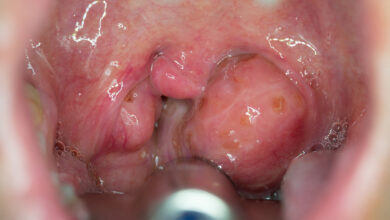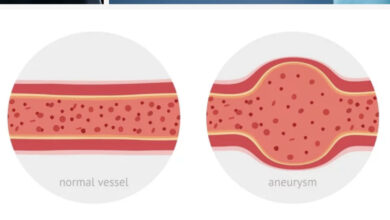”I Thought He Had a Stroke!” Bell’s Palsy: The Masked Paralysis

That’s what his wife said when she brought him in because one side of his face was paralyzed. He could talk, he could walk, he could move both arms, but one side of his face was motionless. She breathed a sigh of relief when I told her, instead of a stroke, he had Bell’s Palsy. Yes, he had a less worrisome, less ominous, but just the same, bothersome problem. He had acquired a temporary paralysis of the 7th cranial nerve, The Facial Nerve.
The Facial Nerve makes our face move. There are two facial nerves, one on each side of the head. Branches of the Facial Nerve bring about wrinkling of the forehead, blinking of the eyes, squinting, smiling, frowning, and whistling. When the Facial Nerve is paralyzed, as it is in Bell’s Palsy, none of these functions occur.
A stroke, on the other hand, is an insult to the brain. Deep within the brain are found nuclei, or clusters of cells, which send impulses to the nerve each nucleus controls. Fibers from each nucleus decussate, or crossover, from one side of the brain to the other and combine to form a single nerve. Each nerve has one or several functions controlled by its nucleus. When a stoke occurs on one side, the effect is seen on the opposite side of the body because of the crossover (decussation) of nerve fibers from one side to the other.
Depending on the location of a stroke, various abnormalities in sensation and movement occur in the body. When a stoke affects the Facial nerve, only part of the face is affected. The forehead still wrinkles and the eyes still blink, but the mouth will not form a smile or a whistle. The area of the cheek and mouth droop and are immobile. As mentioned previously, in Bell’s Palsy, the entire side of the face is motionless. In a stroke, additional things happen to the nervous system such as the inability to speak and/or paralysis of the arm or leg on the same side as the partial facial paralysis. In Bell’s Palsy only one side of the face is affected, nothing else.
The actual cause of Bell’s palsy is unknown, but a lot of people think it’s a viral infection of the Facial nerve by Herpes simplex (cold sores, fever blister, genital herpes) or Herpes zoster (shingles) viruses. Numerous other viruses are implicated, but scientists simply aren’t certain.
The Symptoms of Bell’s palsy are as follow:
Sudden rapid onset of weakness or paralysis of one side of the face
Facial droop on the affected side
Patient is unable to wrinkle the forehead
Patient is unable to blink or close the eye
Patient is unable to smile or whistle
Dryness of the affected eye
Drooling from the mouth on the paralyzed side
Pain around the jaw and ear on the affected side
Headache
Increased sensitivity to sound on the affected side
Decreased sense of taste
Patients who are pregnant, have diabetes, or currently have an upper respiratory infection, hand-foot-mouth disease, shingles, cold sores or genital herpes are at risk of Bell’s palsy.
The diagnosis is made by clinical observation of the symptoms. The doctor sees the whole face is paralyzed. But in some cases an EMG or MRI are necessary to confirm diagnosis.
Most cases (80-90%) of Bell’s palsy resolve almost completely within six months of onset. It may be helpful and shorten the duration of paralysis by using corticosteroids, particularly Prednisone, early on to reduce nerve inflammation and swelling. Anti-viral, specifically anti-herpes, drugs have been shown to shorten the duration, as well. In the past, a Hilger Nerve Stimulator was used to electrically stimulate the nerve for two reasons—(1) diagnostic-to see if the nerve was dead, (2) therapeutic-stimulation might make paralysis disappear sooner. This method was not mentioned in any of my references and is no longer in use.
Eye protection is important in management because the inability to blink causes dryness of the cornea. Artificial tears, eye ointments, and/or taping the eyelid shut, or patching, especially at night, are good protections to prevent corneal damage.
In rare cases, Bell’s palsy can affect both sides at the same time. It may recur on the same or other side in 4-14% of patients. Recurrent or persistent cases should be evaluated for an underlying cause using CT or MRI imaging.
Dr. G’s Opinion: Bell’s palsy is not terribly common, but I saw at least 2-4 cases a year. Most patients do worry they have had a stroke and are relieved to find out otherwise. Drooling and dry eye are the most troublesome affects of the one-sided paralysis and must be dealt with. The majority of patients have full resolution of paralysis, but a few will have a remaining touch of paralysis while blinking, smiling, or wrinkling the forehead.
If one has the sudden onset of Bell’s palsy, it’s important to see your doctor for confirmation, and get started on prednisone and anti-herpes therapy, if indicated, right away.
References: Taylor DC, Benbadis SR. Bell’s Palsy. Medscape Nov 8, 2018.
www.ninds.nih.gov/disorders/patient-caregiver-education/fact-sheet/Bells-palsy




